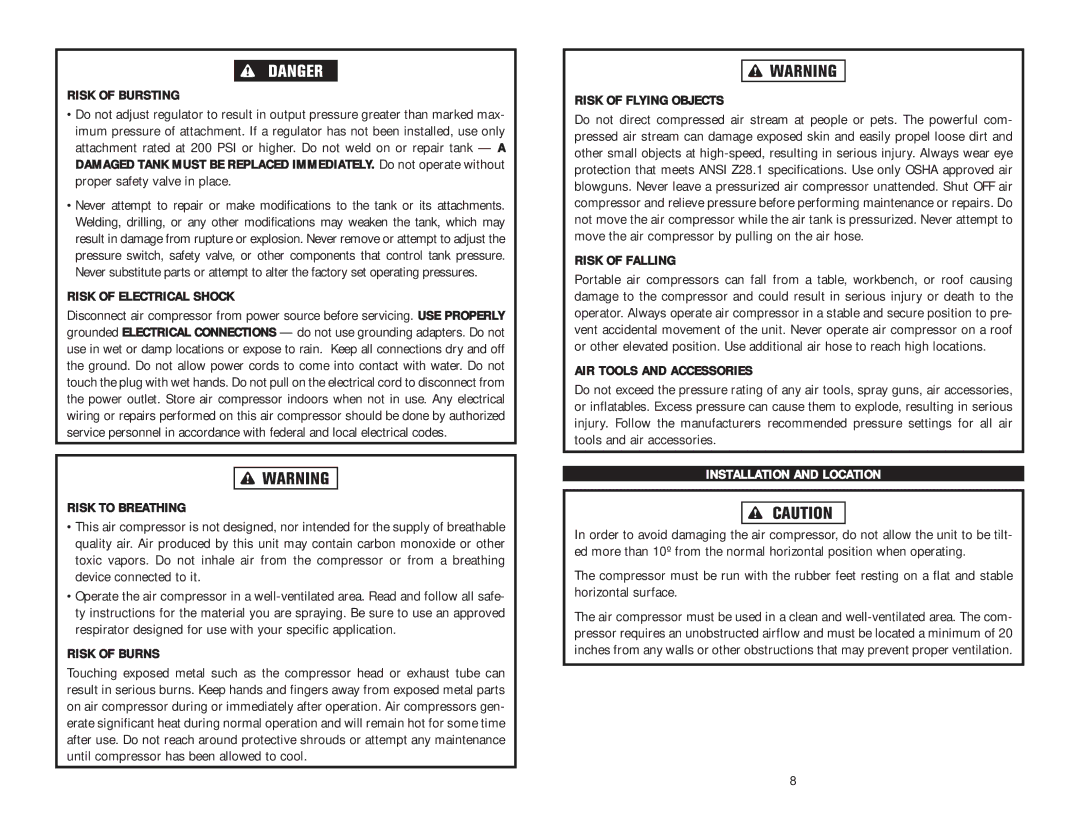
RISK OF BURSTING
•Do not adjust regulator to result in output pressure greater than marked max- imum pressure of attachment. If a regulator has not been installed, use only attachment rated at 200 PSI or higher. Do not weld on or repair tank — A DAMAGED TANK MUST BE REPLACED IMMEDIATELY. Do not operate without proper safety valve in place.
•Never attempt to repair or make modifications to the tank or its attachments. Welding, drilling, or any other modifications may weaken the tank, which may result in damage from rupture or explosion. Never remove or attempt to adjust the pressure switch, safety valve, or other components that control tank pressure. Never substitute parts or attempt to alter the factory set operating pressures.
RISK OF ELECTRICAL SHOCK
Disconnect air compressor from power source before servicing. USE PROPERLY grounded ELECTRICAL CONNECTIONS — do not use grounding adapters. Do not use in wet or damp locations or expose to rain. Keep all connections dry and off the ground. Do not allow power cords to come into contact with water. Do not touch the plug with wet hands. Do not pull on the electrical cord to disconnect from the power outlet. Store air compressor indoors when not in use. Any electrical wiring or repairs performed on this air compressor should be done by authorized service personnel in accordance with federal and local electrical codes.
RISK TO BREATHING
•This air compressor is not designed, nor intended for the supply of breathable quality air. Air produced by this unit may contain carbon monoxide or other toxic vapors. Do not inhale air from the compressor or from a breathing device connected to it.
•Operate the air compressor in a
RISK OF BURNS
Touching exposed metal such as the compressor head or exhaust tube can result in serious burns. Keep hands and fingers away from exposed metal parts on air compressor during or immediately after operation. Air compressors gen- erate significant heat during normal operation and will remain hot for some time after use. Do not reach around protective shrouds or attempt any maintenance until compressor has been allowed to cool.
RISK OF FLYING OBJECTS
Do not direct compressed air stream at people or pets. The powerful com- pressed air stream can damage exposed skin and easily propel loose dirt and other small objects at
RISK OF FALLING
Portable air compressors can fall from a table, workbench, or roof causing damage to the compressor and could result in serious injury or death to the operator. Always operate air compressor in a stable and secure position to pre- vent accidental movement of the unit. Never operate air compressor on a roof or other elevated position. Use additional air hose to reach high locations.
AIR TOOLS AND ACCESSORIES
Do not exceed the pressure rating of any air tools, spray guns, air accessories, or inflatables. Excess pressure can cause them to explode, resulting in serious injury. Follow the manufacturers recommended pressure settings for all air tools and air accessories.
INSTALLATION AND LOCATION
In order to avoid damaging the air compressor, do not allow the unit to be tilt- ed more than 10º from the normal horizontal position when operating.
The compressor must be run with the rubber feet resting on a flat and stable horizontal surface.
The air compressor must be used in a clean and
8
